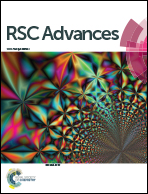Poly[diaquo(1,10-phenanthroline-κ2N1:N10)(μ2-sulphato-κ2O:O′)copper(ii)]: hydrothermal synthesis, crystal structure and magnetic properties†
Abstract
Of late, hydrothermal synthesis has gained much interest in the synthesis of metal–organic hybrid complexes with fascinating architectures and topologies. Product formation in such syntheses often depends on the nature of solvents, counter ions, pH and the ligand geometry. Copper-1,10-phenanthroline, or similar ligand systems, have been very popular in supramolecular chemistry over the years. Hence, a new metal–organic hybrid complex poly[diaquo(1,10-phenanthroline-κ2N1:N10)(μ2-sulphato-κ2O:O′)copper(II)], i.e., [Cu(C12H8N2)(H2O)2(μ-SO4)]n was synthesized by the hydrothermal method. Physico-chemical characterization of the complex was done using FTIR spectroscopy, single crystal X-ray diffraction, TGA, EPR, SQUID and FESEM. Single crystal X-ray diffraction studies revealed it to be three-dimensional with space group I2/c (monoclinic) and the unit cell dimensions are a = 7.0081 (3), b = 13.8198 (7) and c = 14.2897 (8) Å; the axial angles are α = 90°, β = 99.282 (5)° and γ = 90°. It features chains in which two successive pairs of Cu(II) ions are connected by SO4 bridges and Cu(II) ions, each coordinated to two H2O molecules and two N-atoms of 1,10-phenanthroline, and the title complex has a distorted octahedral geometry. The alternating polymeric chains are connected through extensive hydrogen bonds between two O-atoms of SO4 bridges from one chain and H atoms of the two coordinated H2O molecules of another chain in the three dimensional architecture. Alternating chains are shifted with respected to each other leading to the formation of zigzag channels within the crystal structure. EPR and SQUID studies revealed the paramagnetic nature of the complex.
![Graphical abstract: Poly[diaquo(1,10-phenanthroline-κ2N1:N10)(μ2-sulphato-κ2O:O′)copper(ii)]: hydrothermal synthesis, crystal structure and magnetic properties](/en/Image/Get?imageInfo.ImageType=GA&imageInfo.ImageIdentifier.ManuscriptID=C6RA03493D&imageInfo.ImageIdentifier.Year=2016)

 Please wait while we load your content...
Please wait while we load your content...